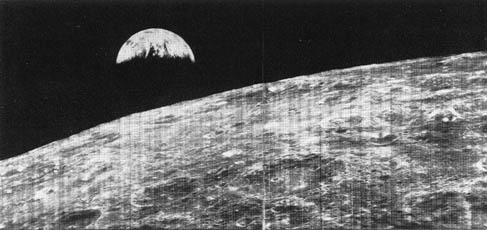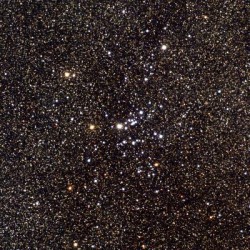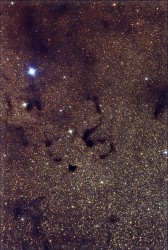[/caption]Greetings, fellow SkyWatchers! Are you ready for a relatively Moon-less weekend? For telescope observers, we’ll travel south and capture the cosmic firefly – the “Bug Nebula”. If you have binoculars, take them out as we journey back 2000 years in time to look at the magnificent M25. For those who like a challenge? Try your luck at being a “Snake” charmer. Even if you just relax in a lawn chair and stare at the stars, you’re in luck because the Northern Iota Aquarid meteor shower is in town for a visit, too! Step out the back door, face south, and let’s journey into the night…
Friday, August 22, 2008 – With the Moon long gone from early evening skies, let’s have a look tonight at NGC 6302, a very curious planetary nebula located around three fingerwidths west of Lambda Scorpii: it is better known as the “Bug” nebula (RA 17 13 44 Dec -37 06 16).
With a rough visual magnitude of 9.5, the Bug belongs to the telescope – but it’s history as a very extreme planetary nebula belongs to us all. At its center is a 10th magnitude star, one of the hottest known. Appearing in the telescope as a small bowtie, or figure 8 shape, huge amounts of dust lie within it – very special dust. Early studies showed it to be composed of hydrocarbons, carbonates and iron. At one time, carbonates were believed associated with liquid water, and NGC 6302 is one of only two regions known to contain carbonates – perhaps in a crystalline form.
Ejected at a high speed in a bi-polar outflow, further research on the dust has shown the presence of calcite and dolomite, making scientists reconsider the kind of places where carbonates might form. The processes that formed the Bug may have begun 10,000 years ago – meaning it may now have stopped losing material. Hanging out about 4000 light-years from our own solar system, we’ll never see NGC 6302 as well as the Hubble Telescope presents its beauty, but that won’t stop you from enjoying one of the most fascinating of planetary nebulae!
 Saturday, August 23, 2008 – Do you remember August 10, 1966 when Lunar Orbiter 1 was launched? Well, on this day in history it made headlines as it sent back the very first photo of Earth as seen from space! While the photographic quality is pretty poor by today’s standards, can you imagine the media stir it caused at the time? Never before had humankind witnessed our own planet. Just think of the advances we’ve in just 42 years!
Saturday, August 23, 2008 – Do you remember August 10, 1966 when Lunar Orbiter 1 was launched? Well, on this day in history it made headlines as it sent back the very first photo of Earth as seen from space! While the photographic quality is pretty poor by today’s standards, can you imagine the media stir it caused at the time? Never before had humankind witnessed our own planet. Just think of the advances we’ve in just 42 years!

Sunday, August 24, 2008 – Today in 1966 from an Earth-orbiting platform, the Luna 11 mission launched on a three day trip. After successfully achieving orbit, the mission went on to study lunar composition and nearby meteoroid streams. Also on this date in 2006, 424 members of the International Astronomical Union shocked the world as they officially declared Pluto “to no longer be a planet.” Discovered in 1930, Pluto enjoyed its planetary status for 76 years before being retired. While text books will have to be re-written and the amateur science community will continue to recognize it as a solar system body, it is now considered to be a “dwarf planet.” At least temporarily…
So far in our southern expedition we’ve mined for globular gems, had our heads in the clouds and squashed a bug. What’s left? Let’s head over to the dark side as we take a look at the “Snake”…

Unlike bright emission and reflection nebulae, these dark clouds are interstellar masses of dust and gas which remain unilluminated. We would probably not even know they were there except for the fact they eradicate star fields we know to be present! It is possible one day they may form stars of their own, but until that time we can enjoy these objects as splendid mysteries – and one of the most fascinating of all is the “Snake.” Put in a widefield eyepiece and relax… It will come to you. Barnard 72 is only a few light-years in expanse and a relatively short 650 light-years away. If at first you don’t see it, don’t worry. Like many kinds of objects, spotting dark nebulae takes some practice.
While you’re out, watch for the peak of the Northern Iota Aquarid meteor shower. Even though the official peak isn’t until tomorrow night, with no Moon to interfere and deep sky to enjoy, you might catch a bright streak! Wishing you clear skies and good luck…
This week’s awesome image are: NGC 6302: The Bug Nebula – Credit: Don Goldman, Lunar Orbiter’s first photo – Credit: NASA, M25 – Hillary Mathis, Vanessa Harvey, REU program/NOAO/AURA/NSF and B 72: The Snake Nebula – Credit: Tom McQuillan/Adam Block/NOAO/AURA/NSF. Thank you!!


RE: M25
“contains two G-type giants”
I thought type G stars (and all other main-sequence stars) were dwarfs. What’s a G-type giant?
“Two giants of spectral type M and two of type G can be found in this cluster, where the G type giants appear to be actual members (the M’s not). Moreover contains the variable star U Sagittarii of type Delta Cephei, which has a period of 6.74 days, a typical period for these variables “in our neighborhood,” as Cecilia Payne-Gaposhkin put it. It was discovered by J.B. Irwin in 1956, its membership was confirmed by radial velocity measurements conducted by M.W. Feast of Radcliffs Observatory (the common RV of the cluster members is +4 km/sec).”
**Brent A. Archinal and Steven W. Hynes, 2003. Star Clusters. Willmann-Bell, Inc., Richmond [ADS: 2003stcl.book…..A]
Class G stars are probably the best known, if only for the reason that our Sun is of this class. Most notable are the H and K lines of Ca II, which are most prominent at G2. They have even weaker hydrogen lines than F, but along with the ionized metals, they have neutral metals. There is a prominent spike in the G band of CH molecules. G is host to the “Yellow Evolutionary Void”. Supergiant stars often swing between O or B (blue) and K or M (red). While they do this, they do not stay for long in the G classification as this is an extremely unstable place for a supergiant to be. G stars represent about 1 in 13 of the main sequence stars in the solar neighborhood.
“We have checked the reality of the yellow evolutionary void (which is an area in the Hertzsprung-Russell diagram where atmospheres of blueward evolving super- and hypergiants are moderately unstable), by comparing one star inside the void: HD 33579 (= R76), and two at the low-temperature border of it: HR 8752 (= HD 217476, V509 Cas) and IRC+10420. We found that the first star has a large mass and a fairly stable behaviour over time. These aspects suggest, together with abundance determinations by others, that it is a fairly young, still redward-evolving supergiant. For such a star the void is not forbidden. The two other stars, HR 8752 resp. IRC+10420, have low masses which places them in the post-red blueward loop. They show indications of the expected bouncing effect for blueward returning red supergiants: when approaching the void they eject mass, resulting in a sudden reduction of T_eff and a decrease of the atmospheric acceleration to g_eff =~ zero. Thereafter T_eff and g_eff increase again. For HR 8752 two such recent `bounces’ have been identified. The photometric variations of HR 8752 and of HD 33579 are due to high-l gravity-wave pulsations. Based on observations at the La Palma Observatory and the ESO Observatory in Chili.”
**Nieuwenhuijzen, H.; de Jager, C.
To make a long story short, a G-type giant is an oddity that’s slipped through the stellar evolutionary cracks – well worth observing M25 just for that reason!
Tammy,
Thanks for the explanation.
Love the website and Astronomy Cast.
You are very, very welcome! 😀